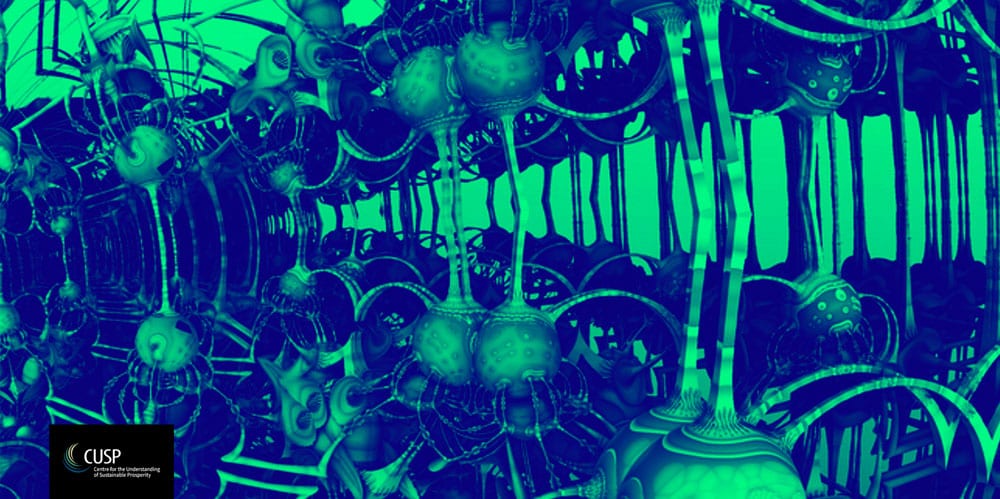Emergence of new energy-transition models: A review
Journal Paper by Sarah Hafner, Annela Anger-Kraavi, Irene Monasterolo and Aled Jones
Ecological Economics | July 2020

The challenges of the 21st century are undoubtedly massive. Accordingly, calls to new approaches in economics are gaining traction in academic and non-academic spheres alike: In order to meaningfully capture features of modern economies—including for example complexity, non-equilibrium and uncertainty—new economic models are sought to apply a systems-perspective and be capable of evaluating multidimensional policy objectives, such as wellbeing alongside GDP, environmental sustainability and distributional issues (OECD, 2017).
In a new journal paper, CUSP researchers Sarah Hafner, Aled Jones and colleagues are diving deep into the growing body of work and compare current energy-transition models in the ecological economics landscape against their ability to consider the desired features, including the following: i) complexity, non-linearity, non-ergodicity and deep uncertainty), (ii) the importance of time, (iii) agents’ heterogeneity and behavioural elements, (iv) interdisciplinary aspects (v) role of institutions and social context, (vi) ethical and philosophical aspects, (vii) finance and viii) multiple equilibria/disequilibrium.
The study identifies eleven relevant energy-transition ecological macroeconomics models. These include E3ME (Cambridge Econometrics, 2019), Panta Rhei / Ginfors (Wiebe et al., 2016), MEDEAS (Capellán-Pérez et al., 2017), Threshold 21/ SDGi (Millennium Institute (2017), EURACE (Raberto et al., 2018), EUGOGREEN (D’Alessandro et al., 2020), ENGAGE / DSK (Lamperti et al., 2018; 2019), LowGrow SFC (Jackson & Victor, 2019), EIRIN (Monasterolo & Raberto, 2019), a model developed by Naqvi, 2015 and a model developed by in Safarzyńska & van den Bergh (2017).
A couple of outstanding examples of model structures that capture particularly interesting features of a new economic approach are given in the following: the agent-based model developed in Safarzyńska & van den Bergh (2017) includes a ‘keep up with the Joneses-effect’ (related to social comparison between agents) and a ‘snob-effect’ (related to status seeking), by introducing interdependences between preferences of different consumers (related to feature (iii) and (iv)). The EIRIN model represents expectations of investors and banks on asset values subsequent to the introduction of climate policies. It shows that the inclusion of these expectations is relevant in understanding climate related transition risks of climate policy introduction on financial system’s stability. EIRIN or EURACE allow to assess impacts of green quantitative easing (see features (iii), (v) and (vii)). Jackson & Victor (2019) provide a prominent example of a Stock-flow-consistent model that represents various dimensions of sustainability (iii, iv). EUROGREEN represents technological change driven by ‘automation technology’ by introducing capital that substitutes middle-skill work, but complements high, and to some extent low, skill work (iii).
The study overall concludes that (a) the knowledge base and structure of these existing ecological macroeconomic models are—alongside other types of models—potentially key for the creation of a new approach in economics, and that (b) the reviewed models are policy relevant, especially in the context of the complexity and urgency of rapid energy transitions, where policymakers increasingly require economic models able to capture real-world characteristics.
Further developments are required still, and our comparative study suggests that future research should focus on i) comparability of models’ results and their policy insights, ii) further incorporation of the relationships between macroeconomics, finance and sustainability, and iii) the development of a ‘best practices’ guide with regard to the representation of specific model structures (e.g. production function, consumption function) for specific model-purposes (e.g. exploration of energy innovation policy effects).
A more in-depth investigation on how complexity features are or could be accounted for in current energy-transition models will be undertaken within a new research project in which Anglia Ruskin University is a partner. The Economics of Energy Innovation and Systems Transition (EEIST) project is funded by the UK Department for Business, Energy & Industrial Strategy (BEIS) and led by the University of Exeter.
References
Cambridge Economics (2019). E3ME. Technical Manual, Version 6.1. March 2019. Available: https://www.e3me.com/wp-content/uploads/2019/09/E3ME-Technical-Manual-v6.1-onlineSML.pdf (01.02.2019).
Capellán-Pérez, Iñigo, ñigo Capellán-Pérez (ICM-CSIC), Ignacio de Blas, Jaime Nieto, Carlos de Castro, Luis Javier Miguel, Margarita Mediavilla, Óscar Carpintero, Paula Rodrigo, Fernando Frechoso & Santiago Cáceres (2017). Guiding European Policy toward a low-carbon economy. Modelling sustainable Energy system Development under Environmental and Socioeconomic constraints. D4.1 (D13) Global Model: MEDEAS-World Model and IOA implementation at global geographical level. Available at http://medeas.eu/deliverables (31.07.2018).
D’Alessandro, S., Cieplinski, A., Distefano, T., & Dittmer, K. (2020). Feasible alternatives to green growth. Nature Sustainability, 1-7.
Giles (2009). Wishful thinking and hubris – why the global financial crisis was not foreseen. Available at: http://www.lse.ac.uk/website-archive/newsAndMedia/news/archives/2009/07/LettertoQueen2.aspx (01.04.2019).
Haldane, A. G., & Turrell, A. E. (2018). An interdisciplinary model for macroeconomics. Oxford Review of Economic Policy, 34(1-2), 219-251.
Knight, F. H. (1921). Risk, uncertainty and profit. New York: Hart, Schaffner and Marx.
Lamperti, F., Bosetti, V., Roventini, A., & Tavoni, M. (2019). The public costs of climate-induced financial instability. Nature Climate Change, 9(11), 829-833.
Lamperti, F., Dosi, G., Napoletano, M., Roventini, A., & Sapio, A. (2018). Faraway, so close: coupled climate and economic dynamics in an agent-based integrated assessment model. Ecological Economics, 150, 315-339
Millennium Institute (2017). Model documentation. Available at: https://www.millennium-institute.org/documentation (15.12.2018).
Monasterolo, I., & Raberto, M. (2019). The impact of phasing out fossil fuel subsidies on the low-carbon transition. Energy Policy, 124, 355-370.
OECD (2017). New Approaches to Economic Challenges. Towards a new narrative. Available at: http://www.oecd.org/naec/OSG%20NAEC%20Forum%20report.pdf (20.04.2019).
Posner, R. A. (2009). A failure of capitalism: The crisis of’08 and the descent into depression. Harvard University Press.
Raberto, M., Ozel, B., Ponta, L., Teglio, A., & Cincotti, S. (2018). From financial instability to green finance: the role of banking and credit market regulation in the Eurace model. Journal of Evolutionary Economics, 1-37.
Stiglitz, J. E. (2018). Where modern macroeconomics went wrong. Oxford Review of Economic Policy, 34(1-2), 70-106.
Jackson, T and P A Victor (2018). LowGrow SFC: a stock-flow-consistent ecological macroeconomic model for Canada. CUSP Working Paper No 16. Guildford: Centre for the Understanding of Sustainable Prosperity.
Wiebe, K. S., & Lutz, C. (2016). Endogenous technological change and the policy mix in renewable power generation. Renewable and Sustainable Energy Reviews, 60, 739-751.
The article can be accessed via the Science Direct website. If you have difficulties accessing the paper, please get in touch: info@cusp.ac.uk.
Citation
Hafner S, Anger-Kraavib A, Monasterolo I and A Jones 2020. Emergence of New Economics Energy Transition Models: A Review. Ecological Economics, Vol 177.



